Art World
10 of the Most Eye-Opening Artworks at Art Basel Miami Beach
From new directions by stars like Keltie Ferris and Parker Ito to classics from Matta and Bruce Nauman.
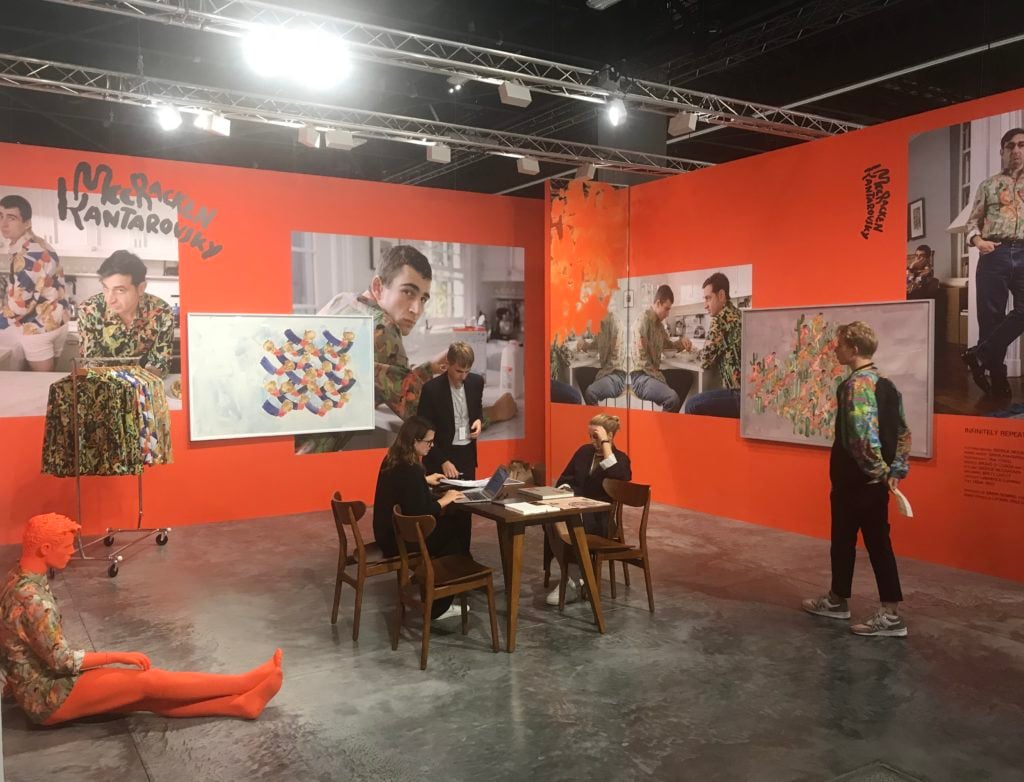
From new directions by stars like Keltie Ferris and Parker Ito to classics from Matta and Bruce Nauman.

Amid wildfires in California, ongoing sexual-harassment revelations, the geopolitical mystery around the Salvator Mundi, and the general chaotic state of life in Trump’s America, it required some effort to keep one’s attention on the goings-on at Art Basel Miami Beach this year, where the journalistic imperative is to play a frenzied game of “Supermarket Sweep” in pursuit of the ultimate prize: a good yarn. A sense of restless dissatisfaction was palpable at the fair, both in the art on view and among the dealers showing it, though reliable pockets of ingenuity, entrepreneurial verve, and future-plotting leavened the proceedings enough to power one along through the miles of aisles.
Here, below, are 10 displays that caught the eye—and ear—of artnet News’s Andrew Goldstein.
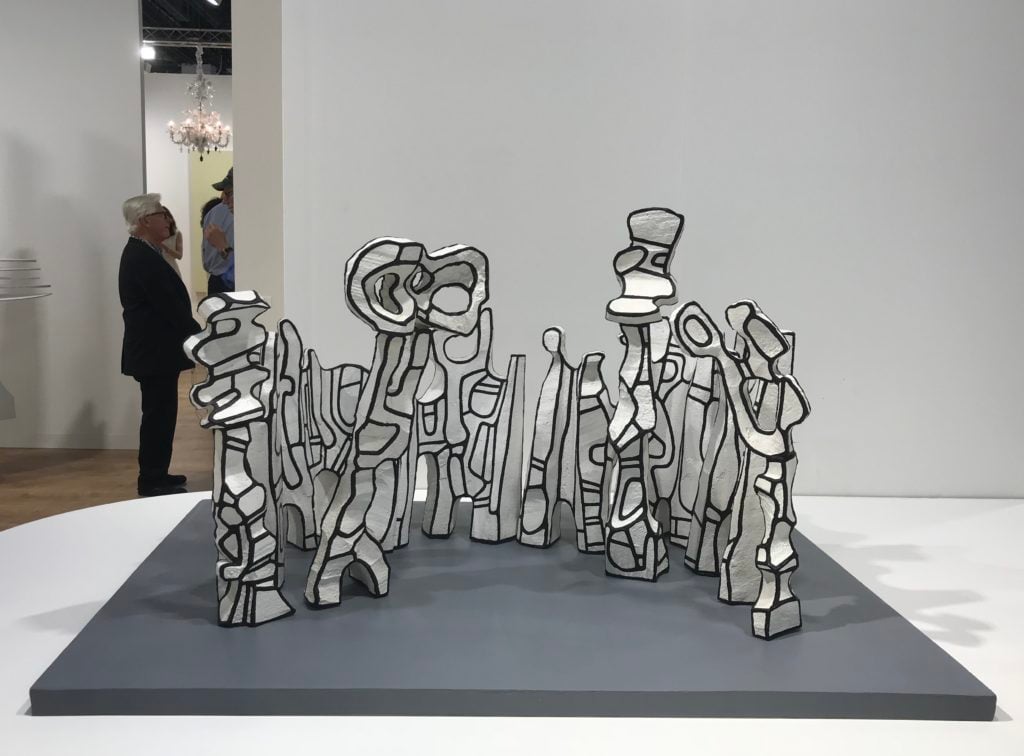
Big things come in little packages at Pace Gallery’s booth, where one of the curatorial coups of the fair is a waist-high platform containing modestly scaled tabletop sculptures by the likes of Tony Smith, Jean Dubuffet, Alexander Calder, Louise Nevelson, Joel Shapiro, and Sol LeWitt—with the twist being that these are not just mini trophies but actually maquettes, designed to be enlarged into enormous outdoor sculptures.
The hors-d’oeuvre–like assortment is a playful nod to Pace’s history of producing such monumental works with its artists, and some of the pieces at the fair are indeed for sale in their large format—like the serpentine black Smith, for $3 million—while others are available only in maquette form, like the mountainous Calder for $875,000.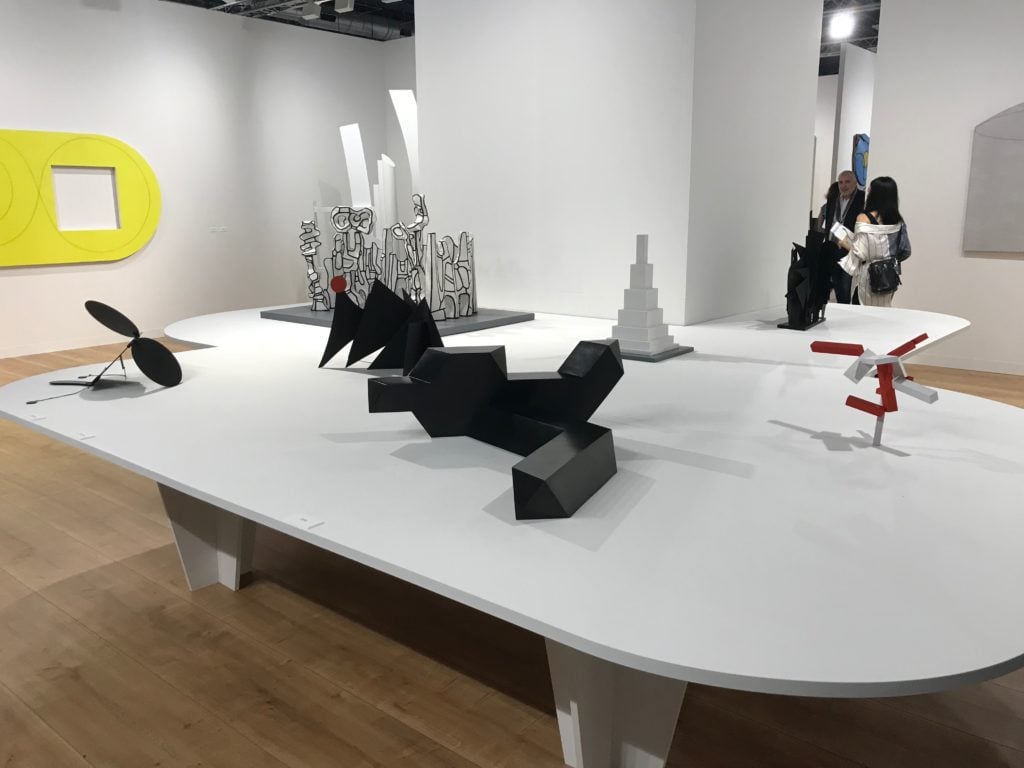
It all depends on the artist’s wishes, explained Pace’s Marc Glimcher. “Calder left instructions that nothing be made after his death,” he said, while, on the other hand, “Dubuffet left detailed instructions in his will” for fabricating large versions of his designs, such as the breathtaking black-and-white Théâtre aux Arbres from 1970, which can be constructed at a vast 28 feet tall by 40 feet wide for $12 million.
Glimcher is a particularly effective salesman for the Dubuffet landscape, because he grew up with one around the house. In 1978, the artist gave a Théâtre aux Arbes as a gift to Arne Glimcher, Pace founder and Marc’s father, on the condition that the dealer managed to get it out of Paris. “We cut it into pieces, just like a barn,” Marc Glimcher recalls.
Now it sprawls across the lawn of Arne Glimcher’s East Hampton home, where it has evolved to serve multiple uses. “If you have kids who secretly want to get stoned in your father’s Dubuffet house, I’ve heard that’s a great place for it,” the younger Glimcher notes. Perhaps owing to its versatility, the sculpture was “almost sold” on the fair’s opening day.
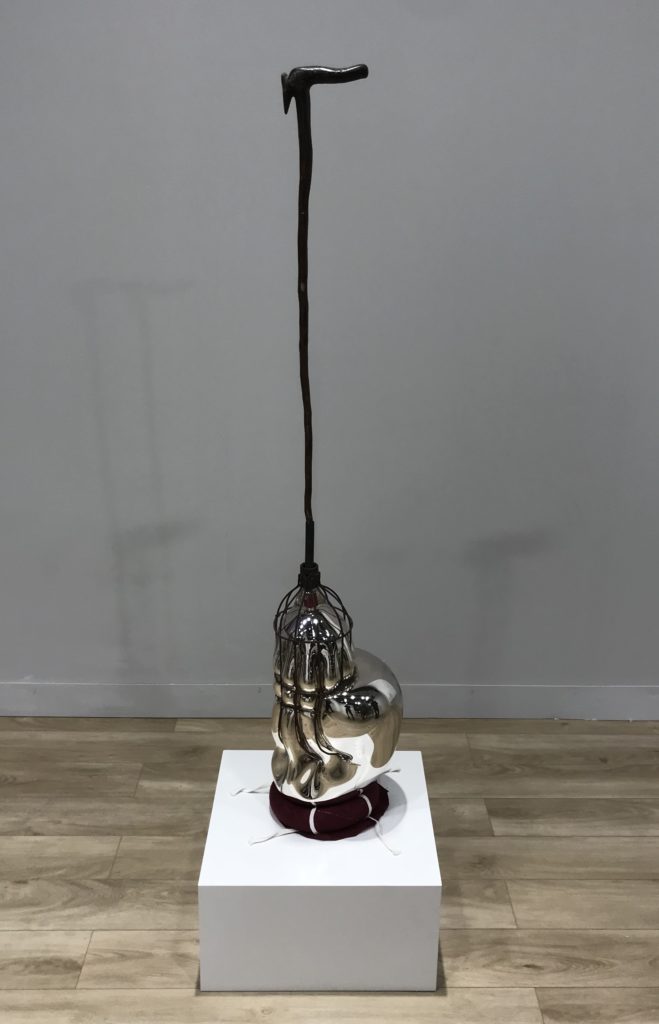
Last month Lévy Gorvy took on representation of the artist Terry Adkins, who died at age 59 in 2014. Now the gallery is working at full tilt to bring due attention to the mercurial, challenging, and important artist. A son of two musicians—he first pursued guitar heroics, inspired by his love of Jimi Hendrix—Adkins committed himself to the study of printmaking and evolved into an artist who defied easy categorization, interweaving music and fine art in his pursuit of magical juxtapositions, often ones that shed light on chapters of African-American culture and art history.
At the fair, Lévy Gorvy has a 2013 sculpture that illustrates Adkins’s complexity. Sitting on a low plinth, it consists of a wood-and-metal fruit picker made by the fabled African-American inventor George Washington Carver, which in turn grips a lumpish head-shaped globe of hand-blown glass with silver patina, which rests atop a red pillow that the artist once wore as a hat during performances with his multidisciplinary musical troupe, the Lone Wolf Recital Corps.
One of the challenges of working with Adkins’s estate is that, in his pursuit of intuitive connections, he was rather unconcerned with nitpicky career details. For instance, he used the same title several times for different works, a tricky hurdle to navigate when assembling a catalogue raisonné, as Lévy Gorvy is currently doing. Luckily, the gallery has help from Adkins’s passionately supportive artist friends, including David Hammons, who has undertaken to complete several works that were unfinished when Adkins died, and Charles Gaines, who is curating his debut show at the gallery in January, an in-depth survey of his protean art.
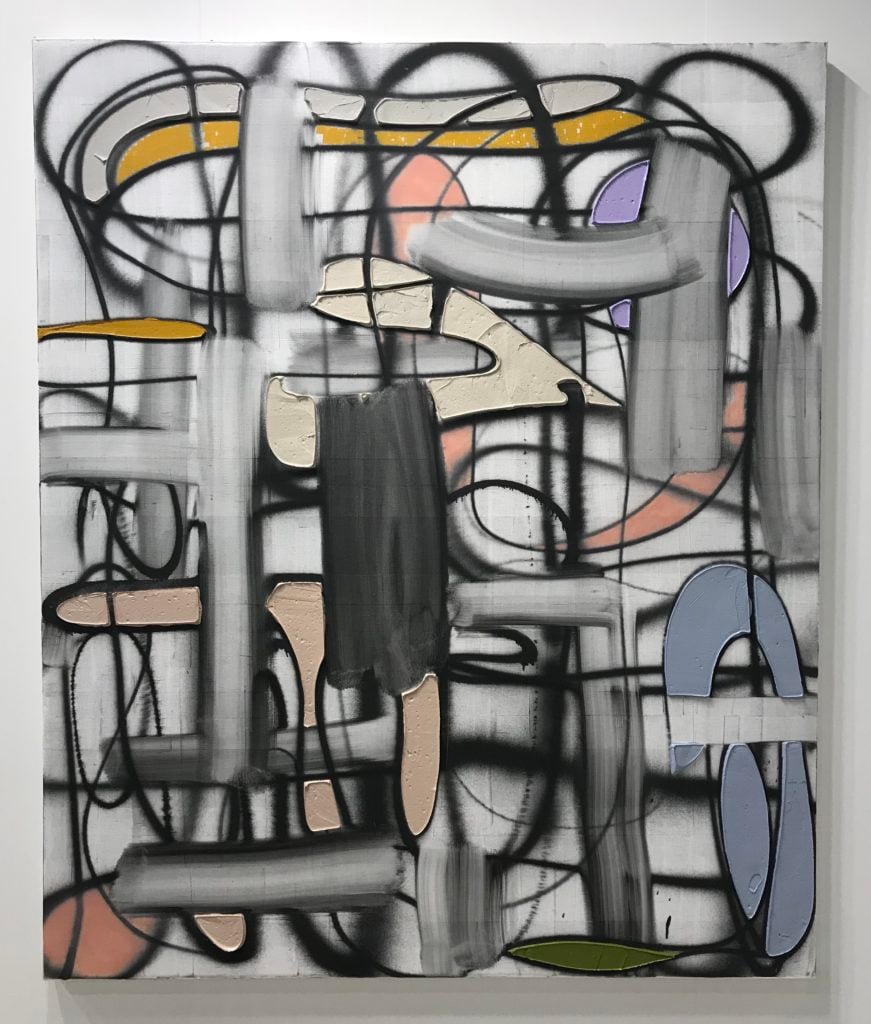
Keltie Ferris became famous for making abstract paintings from meltingly bright blurs of color that seemed both pixelated and powered by the force of their own vibrant chromatic electricity. However, she came to feel trapped by that style, and sought a breakthrough. Around 2014, however, she took up a new approach: Wearing a hardy denim outfit, she would coat her body in linseed oil and then do a pushup of sorts onto a canvas treated with a base layer of Flashe, then sprinkle color pigment on top so that it melds with the oil to become paint. (These works filled her last show at Mitchell-Innes & Nash in 2015.)
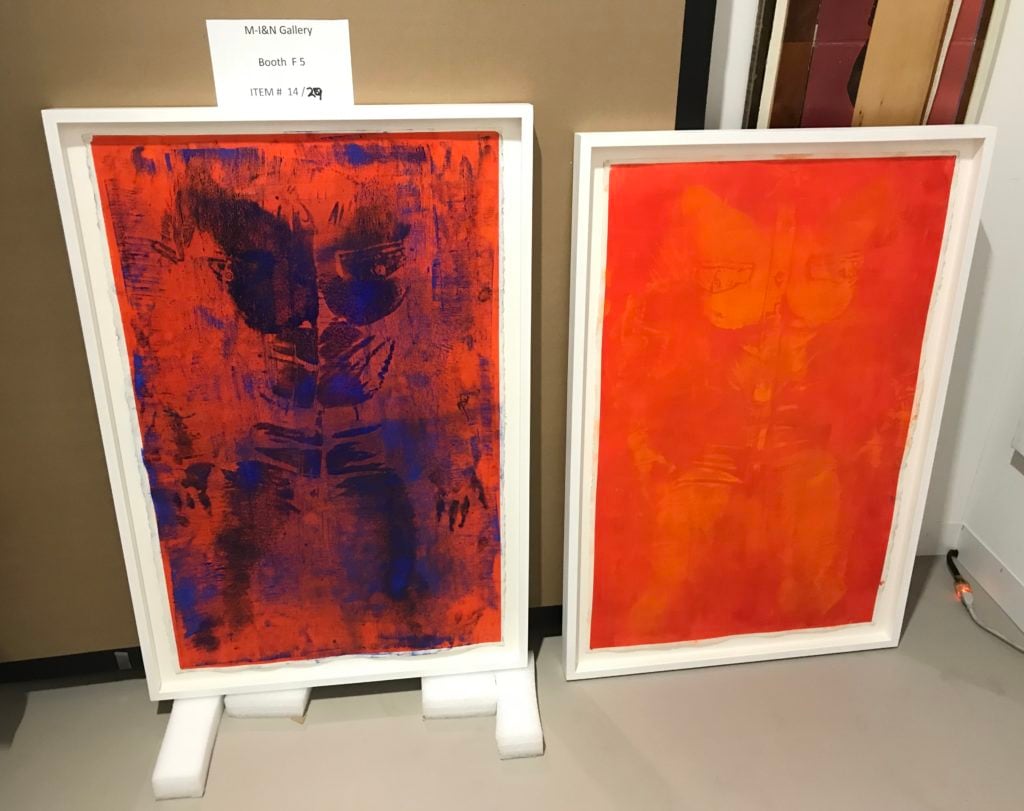
Now, however, Ferris has taken up the brush again, and the works at Art Basel Miami Beach give a glimpse of where she’s going now. The gallery has a fresh painting that again eschews the artist’s formerly vibrant color palette, beginning with a base of black and smeared gray paint that evokes Christopher Wool’s graffiti-esque abstractions and then forming atop this a series lozenges of thickly built-up acrylic in cool, muted colors, recalling the carved-out shapes of AbEx artists like de Kooning. It was joined by two body prints in the back room for $12,500.
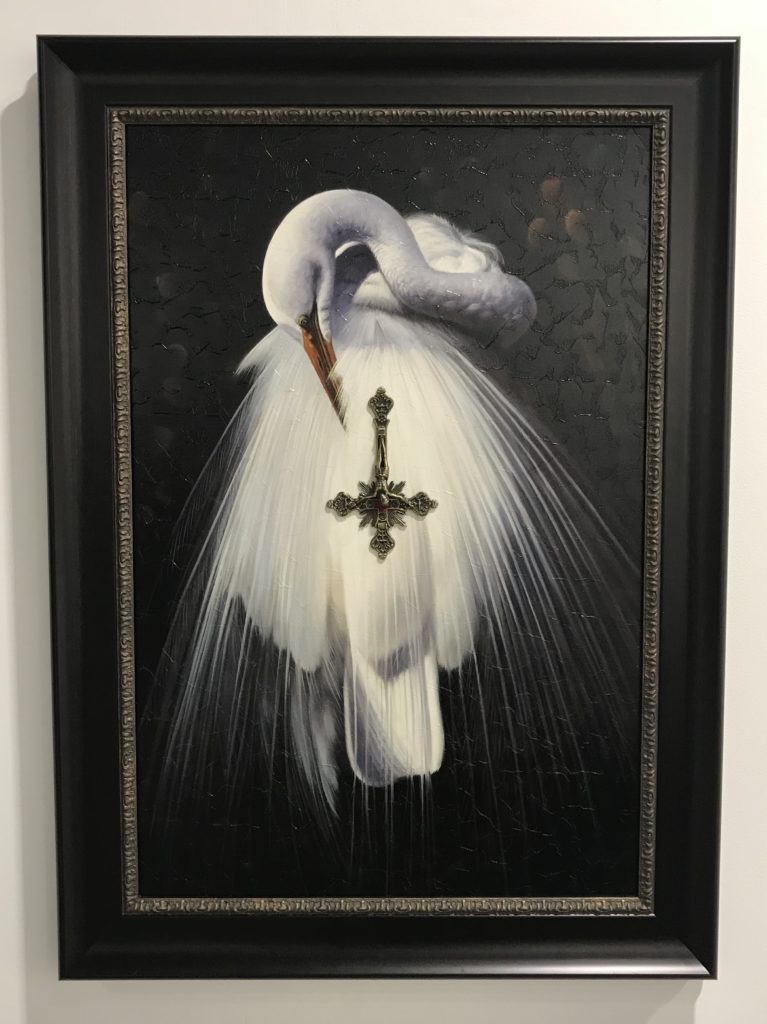
The French-Canadian artist Nicolas Ceccaldi is fascinated by the dark subcultures and religious preoccupations that grow into youth movements during times of unrest and vulnerability. At the fair, he turned his Real Fine Arts solo booth into an exploration of his latest obsession: the Gospel of Judas, a Gnostic text that emerged in 2006 and purports to recount a conversation between Judas Iscariot and Jesus, and which is now used as recruitment material by the Jehovah’s Witnesses.
At the center of his show here, Ceccaldi has placed two racks of these pamphlets ($4,000 per rack), which he détourned by inserting text by the Surrealist poet Lautréamont; around these, he has arrayed some creepy paintings that embrace Judas as the true savior.
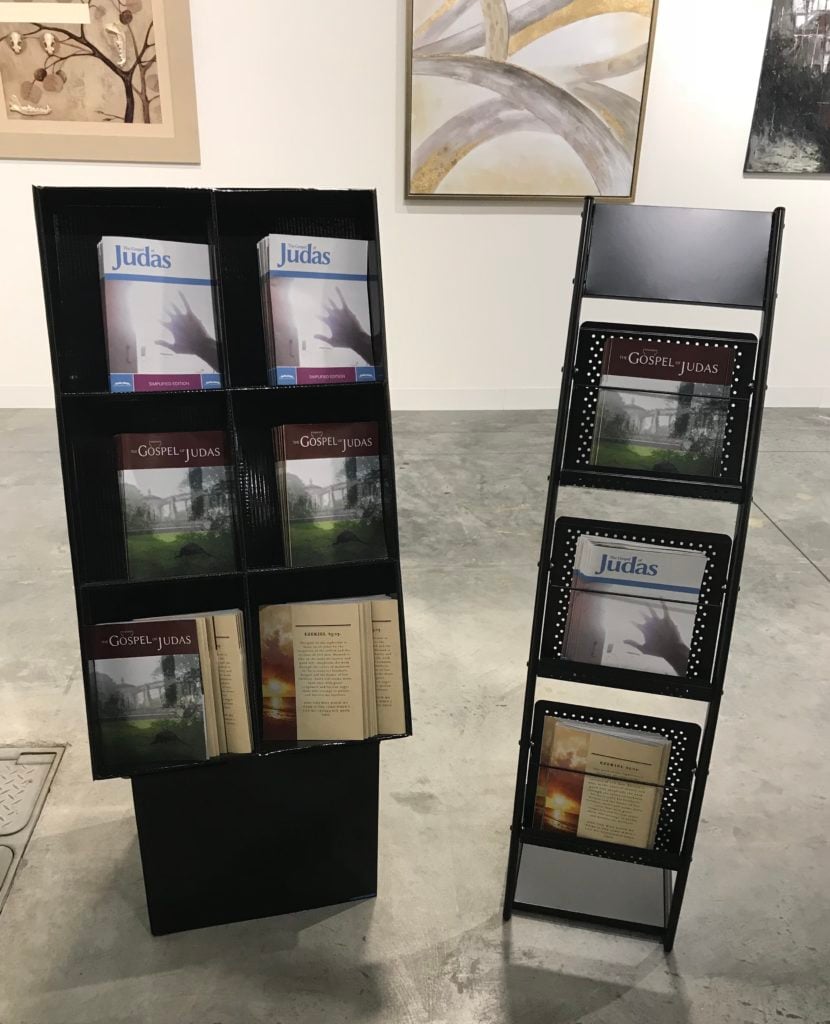
What’s truly unsettling about the paintings? Several of them are readymade, prefab canvases that the artist bought at Raymour and Flanigan! For instance, one eerie painting of a contorted white crane against a funereal black background came directly from the furniture store. All Ceccaldi had to do was place an upside down crucifix on it to make it perfectly satanic. Another involves a prefab painting of gloomy flowers that Ceccaldi made still more unsettling by adorning the flowers with deer skulls topped with fragments of doll faces.
The older brother of Julien Ceccaldi—a painter and breakout star of the last Berlin Biennale—the artist leavened the uncanny proceedings with a mordant joke: Positioning the Gospel of Judas pamphlets next to his dealers’ desk, he effectively recast them as missionaries, proselytizing fairgoers with his surreal religious fantasia.
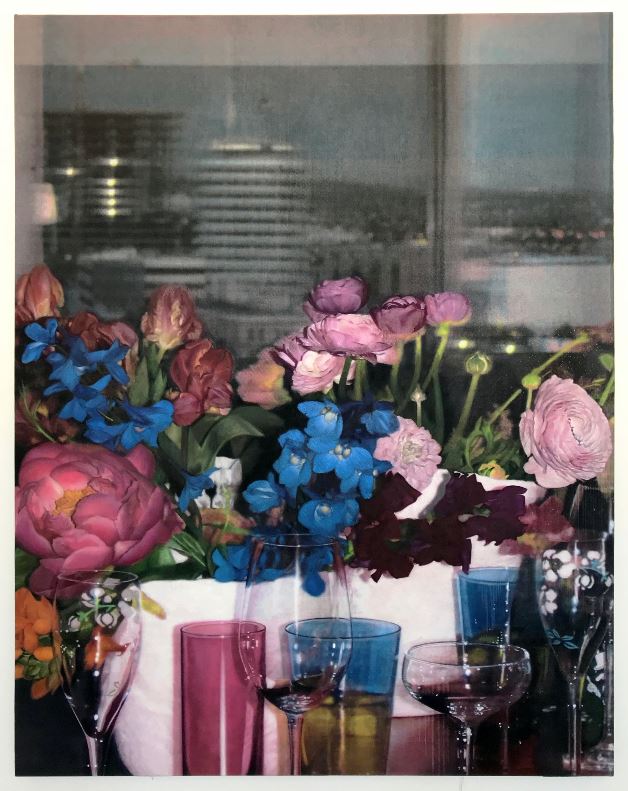
Dealer Jose Freire remembers that when he first met Parker Ito several years ago for a studio visit, the artist was 28 years old and already becoming famous, having early on fallen in with the fast-moving market Svengali Stefan Simchowitz and encouraged to produce new work at a fast clip to meet demand. Everyone knows what happened next: the art-flipping bubble popped, everyone associated with the Zombie Formalist era got dropped like a hot potato, and markets evaporated overnight.
“What happens when people go from zero to $100,000 in a year, and then no one is interested six months later?” Freire asks. “It’s devastating. Imagine what it takes to continue working, to continue caring about what you make.”
A veteran gallerist who has survived more than one downturn, Freire sympathized. “Parker Ito, Hugh Scott-Douglas, Lucien Smith, Christian Rosa—I feel bad for all these people,” he said. “I feel it’s unfair when people try to pin it all on the artist. America is very interested in building icons and knocking them down.” As for Ito, “the exaggerated market of a few years ago created values for the work that were incorrect,” he said, “but I always thought he was a really valuable painter.”
Now 31, the artist has made a concerted effort to turn the page. He moved away from galleries like White Cube and began working instead with the small gallery Château Shatto in Los Angeles, where he lives; he also slimmed down his studio operation and started producing fewer canvases. Now nine of those paintings are on view at Team’s booth, each of them featuring landscapes and iconography from LA, some of them including blown-up Forever postage stamps (which never lose their value despite fluctuations in price), and all of them made through an unusual, high/low-tech process: They were printed on a digital printer that was jury-rigged to recreate images in oil paint, not ink.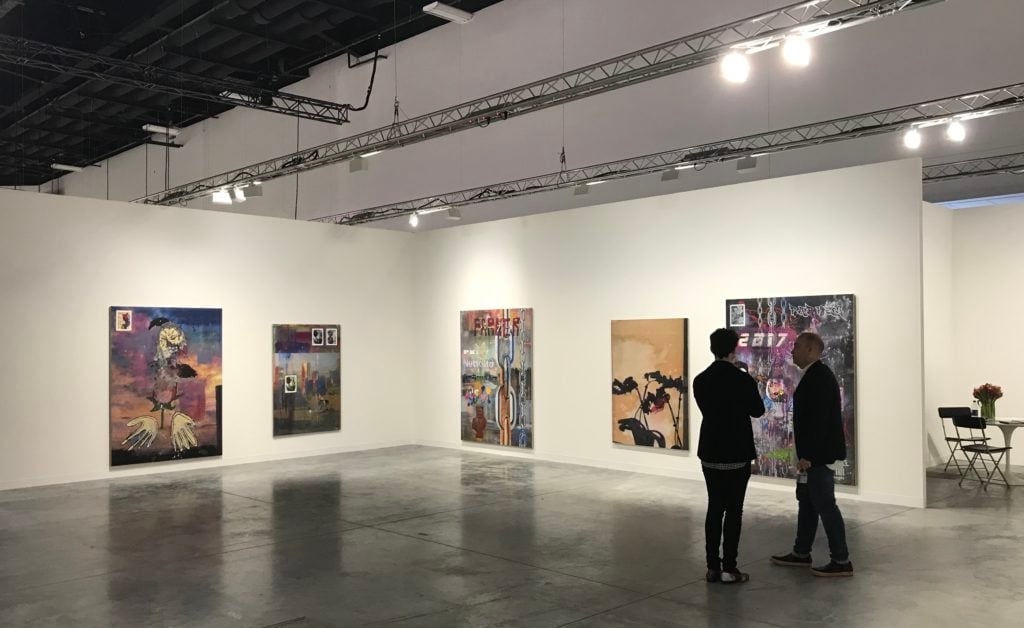
“When you visit Parker and talk to him about the art that he’s looking at and his aspirations as a painter, he really wants to elevate the image, which has become this very degraded thing, to an object of transcendence,” Freire said. “I think what he’s trying to accomplish in his paintings is a great goal.”
A preview of Ito’s debut two-location show at Team Gallery in May (split between the gallery’s SoHo space and the Venice Beach bungalow), the paintings cost $30,000 to $35,000 each, which Freire called “reasonable.” Four had sold and a fifth was on reserve on opening day.
No matter what, however, the dealer does not expect to make any money at the fair. Doing Art Basel Miami Beach, Freire says, was “an unrecoupable cost,” given that the elaborate process behind the paintings incurred high production expenses, and that the booth itself cost $225,000, “incredibly expensive” for a gallery of Team’s size.
It wasn’t worth it, he decided. “This is our thirteenth Art Basel, and it’s our final Art Basel,” the dealer confided, adding that he is considering pulling out of fairs altogether. “To stop doing art fairs at this point makes sense—to continue them would actually be irrational. And I’d rather go out on my terms with a successful final appearance than limp out of here bankrupt.”
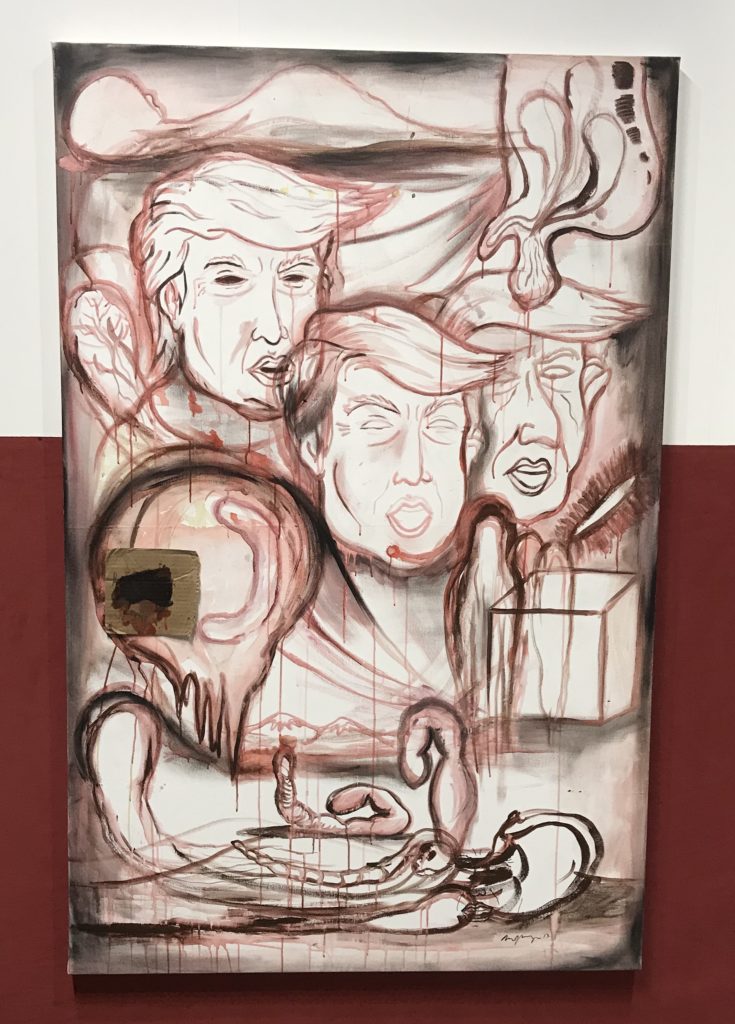
An artist who was born in the Philippines and then rose to prominence in the 1980s LA art world, doing shows alongside figures like Jim Shaw and earning a place in the 1992 Documenta and 1993 Venice Biennale, Manuel Ocampo specializes in sophisticated, often furious satirical paintings that evoke such earlier satirists as Daumier and Hogarth.
His new body of work on view at the fair explores the history of US colonial activities in the Philippines—making special reference to The Forbidden Book: The Philippine-American War in Political Cartoons, a compendium of artworks relating to the 1899-1902 conflict that inspired Rudyard Kipling’s poem “The White Man’s Burden.” (The title of that pro-colonial work, in full, is “The White Man’s Burden: The United States and The Philippine Islands.”)
However, Ocampo—who represented the Philippines in this year’s Venice Biennale—is hardly fixated on the past. One monochrome painting in ochre shows the subject he’s been stewing over: A progression from the bottom to the top, it begins with squirming larvae that spawn grotesque Donald Trump heads that float in a universe of genitalia, with the whole mess crowned by a recumbent Cosmic Child from 2001: A Space Odyssey.
For the artist, who has lived in Manila since 2005, working as a catalyst for the country’s art scene, Trump is not just an American problem. His careening, despotic bluster is enthusiastically echoed by Rodrigo Duterte, the Philippine president accused of employing death squads and other human-rights abuses, whom Trump has repeatedly praised. Once again, an ugly relationship between the US and the Philippines is proving ripe for satire.
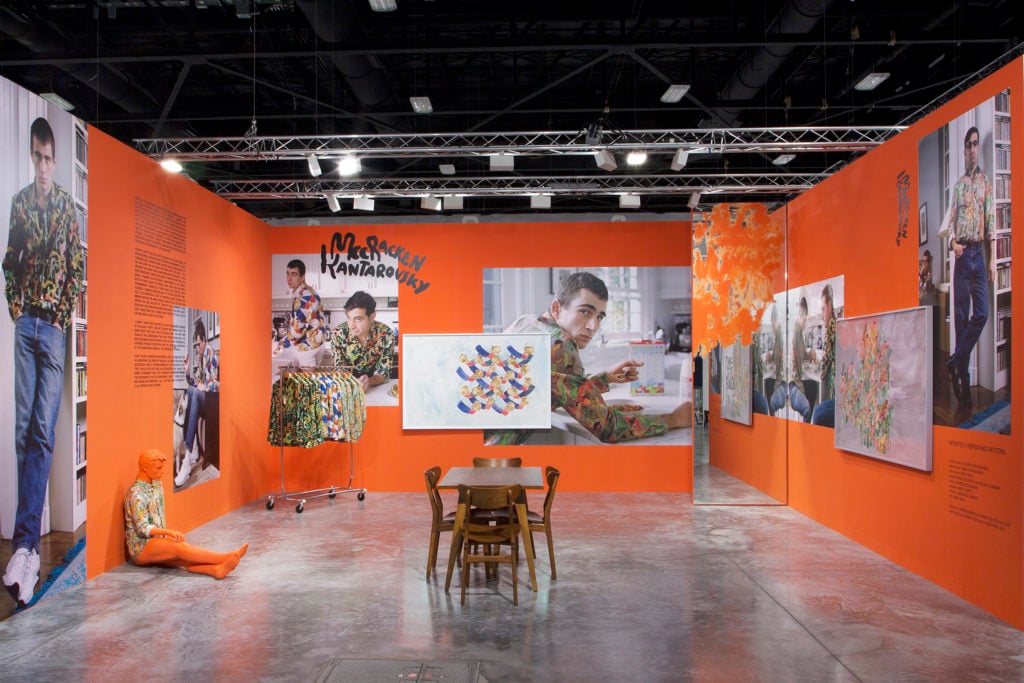
At Tanya Leighton’s booth, the painting phenom Sanya Kantarovsky has a different approach to attacking the Trump era, hitting his ilk where it hurts—their masculinity—and wisely tackling it in a spirit of collaboration. The presentation, in fact, is a real team effort.
To begin with, Kantarovsky made two large-scale watercolors, one showing the painful scene of naked men running headlong into a field of cactuses (with predictably gruesome results) and the other showing a network of wizened old white men strangling each other on their way to the top (done in the colors of the American flag).
The artist then brought in his old art-school friend George McCracken, now the fashion designer behind M-82, to print these compositions onto a line of men’s shirts and jackets, and had photographer Tina Tyrell shoot an “ad campaign” for the clothes at the home of dealer Lawrence Luhring (who now represents the painter, at Luhring Augustine), styling the outfits on professional Acne model Bruno Di Corcia and the artist Nicolás Guagnini.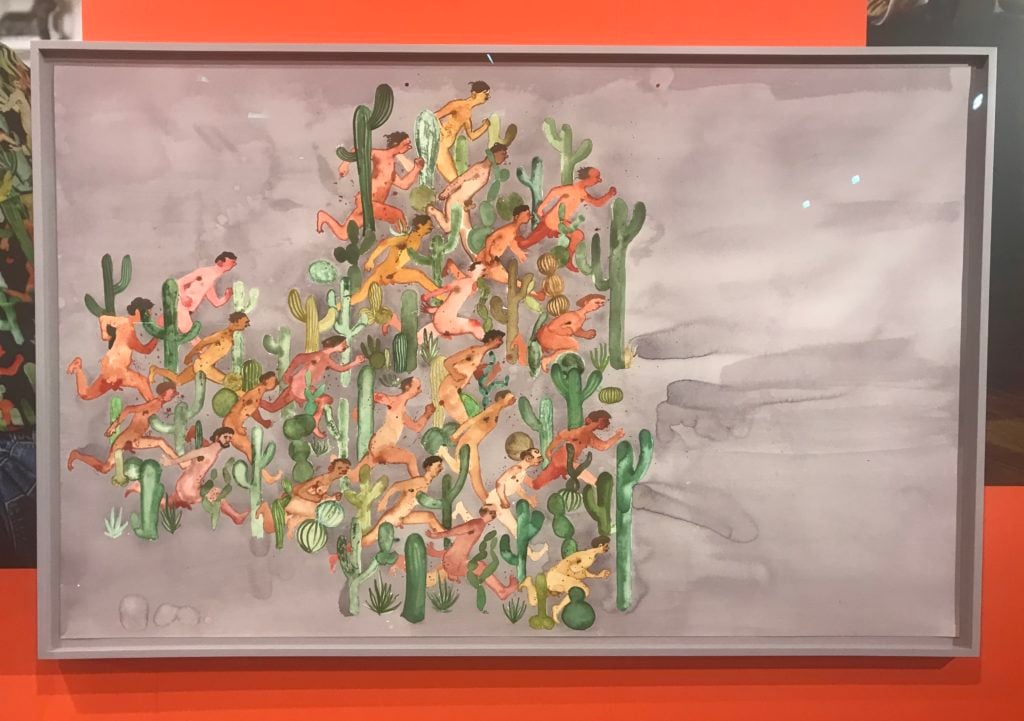
Printed on the walls of the booth, these photos—showing the somewhat menacing models lounging anomalously around Luhring’s pristine upper-class home—are accompanied by a text, written by artist and K-HOLE co-founder Dena Yago. It muses poetically on the vulnerability, guilt, shame, aggression, violence, impotence, and loathing that characterizes the “mythopoeic men” in Kantarovsky’s work, with further implications for the male gender as a whole.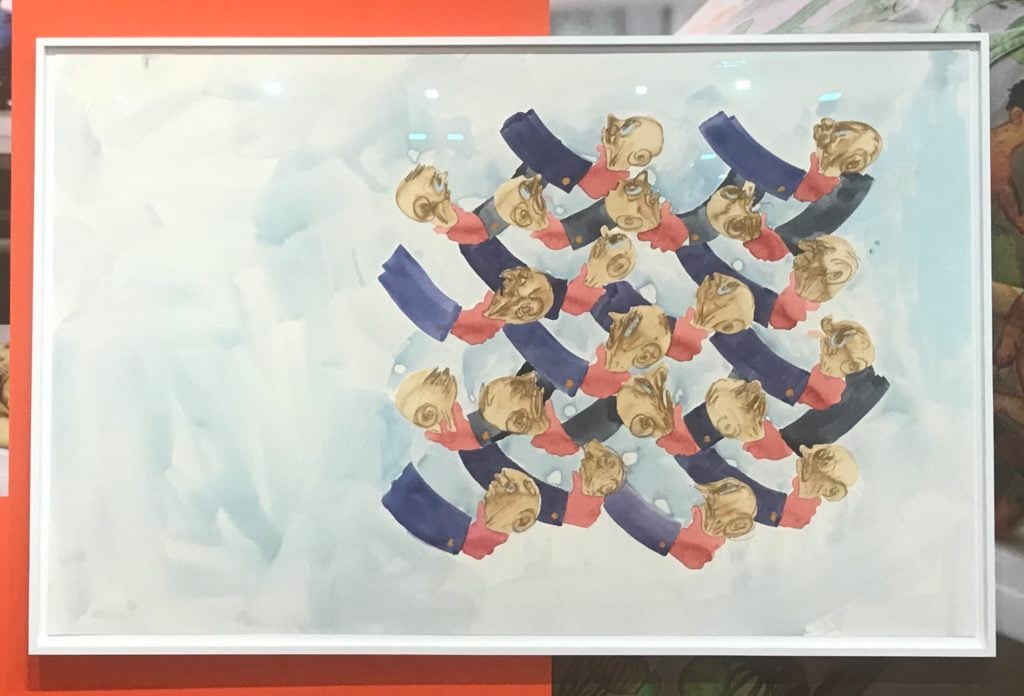
Strange, cutting, and very memorable, the booth is a word-of-mouth sensation at the fair, and shows an exciting advance for Kantarovsky, who has been using his enormous talent with the brush as a jumping-off point for rampant experimentation—through video, variable formats, and immersive mise-en-scène—around what it means to be a painter today.
(Called “Infinitely Repeating Pattern,” the installation is also a preview of sorts for a 4D multimedia extravaganza the artist is planning for his 2018 solo show at the Kunsthalle Basel, picking up the projection technology he employed for his show-stopping Happy Soul at Art Basel Unlimited in 2015.)
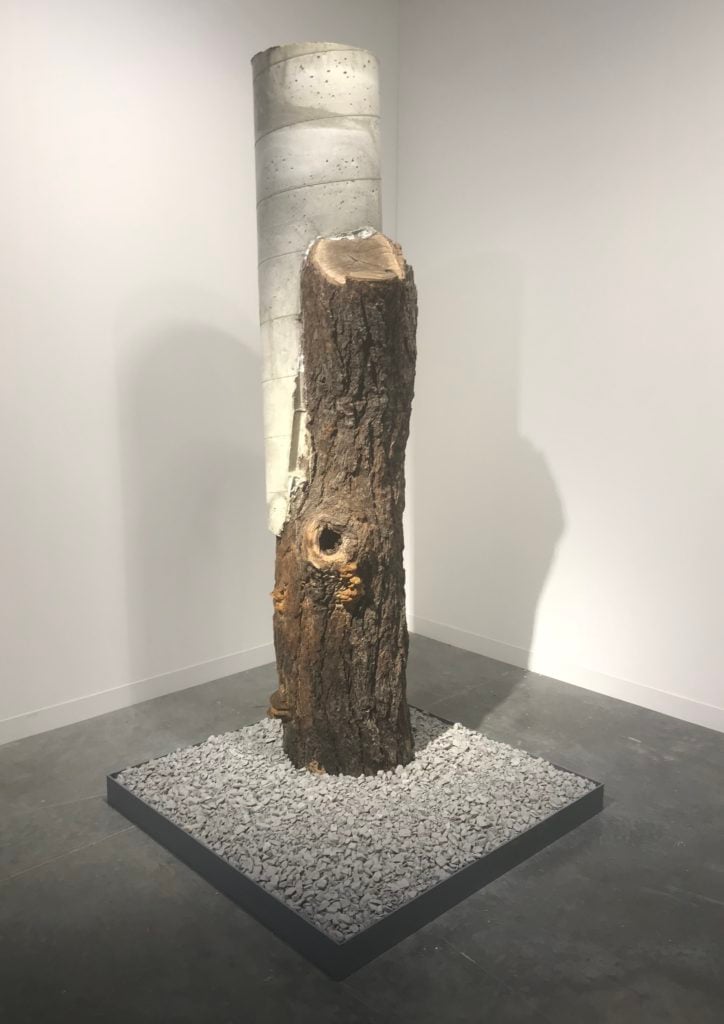
The redoubtable Luhring Augustine gallery is going through a period of revitalization these days, recently snapping up Kantarovsky and also the rising-star sculptor Oscar Tuazon, who has a dynamite piece at the gallery’s booth. Consisting of a walnut tree that has been grafted with a column of concrete, the piece is actually a fountain, intended to be installed outdoors and hooked up to a water line to pump a subtle trickle of water out of the knot in the tree trunk. A living, mutable artwork—it sprouted mushrooms recently when displayed outside the Hammer Museum—it is a product of Tuazon’s deep engagement with the theme of water use and conservation, which runs through his recent work.
The artist is so committed to this subject, in fact, that he has bought a plot of land in a stretch of the Nevada desert where the fragile ecology is currently under threat from a plan to siphon the area’s water to Las Vegas, prompting an outcry from locals and environmental groups. As a way of creating a beacon to draw attention to this crisis, Tuazon plans to turn his property into a “water school,” a building-cum-art installation devoted to the theme of water’s preciousness and featuring a captivating effect: water will continually course through the structure’s windowpanes, thanks to an elaborate piping system.
A modern-day work of Land Art that dealer Roland Augustine compares to Walter de Maria’s Lightning Field, the “water school” project will be represented in Tuazon’s debut show at the gallery this spring, where the watery windowpanes will be on display.
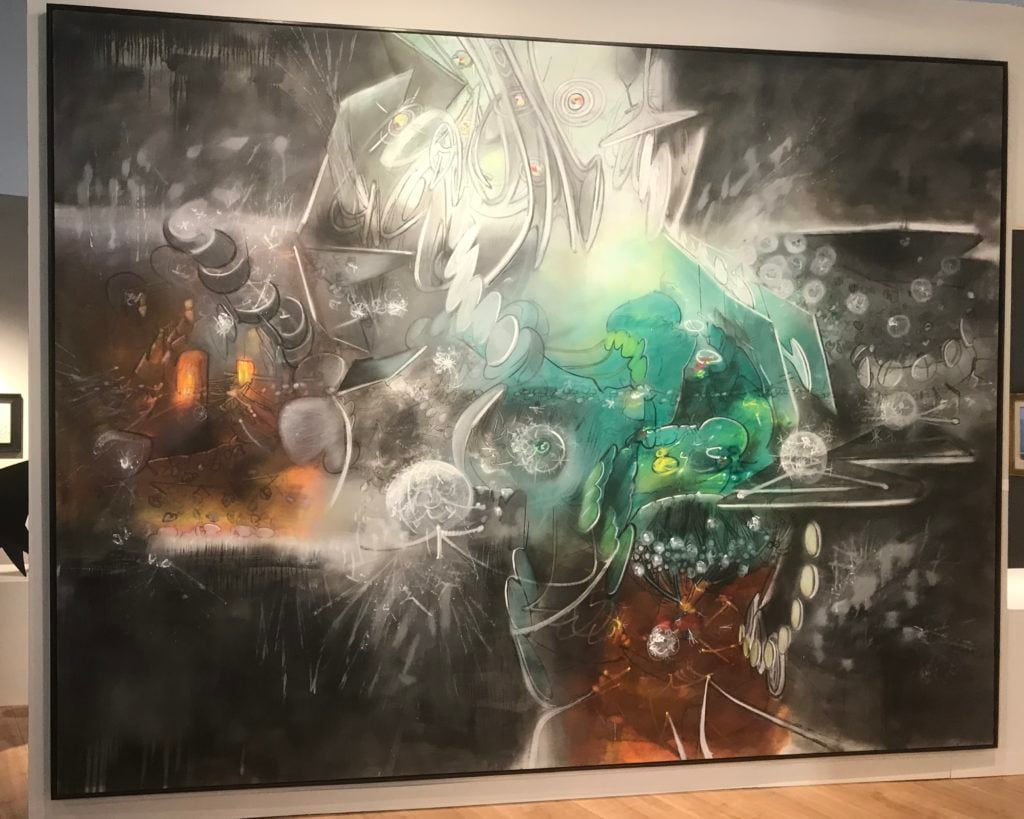
Epic in its billboard scale, the Matta painting at Di Donna gallery furnished one of the fair’s most double-take-inducing moments this year, making it seem like a portal to an alien universe had ripped open in the Miami Convention Center.
The Chilean-born Surrealist titled this colossus The Space-Time of the Dandelion, which somewhat explains the white shapes floating through its expanse like fuzzy Death Stars. It is, all around, just a remarkable thing: sizzling with colors that almost leave a chemical burn on the eye, it roils with dynamism and a sustained richness of composition that flows from edge to edge, a remarkable feat for a painting of this size. It begs for popcorn and a synth-heavy soundtrack.
Painted in 1967, when Matta was 55 and a committed supporter of Chilean socialist Salvador Allende, it is on consignment from the artist’s estate. At $1.1 million, it is a wondrous painting for anyone who can accommodate the thing. Given what you’d pay for a comparable work by, say, Sterling Ruby, it’s a steal.
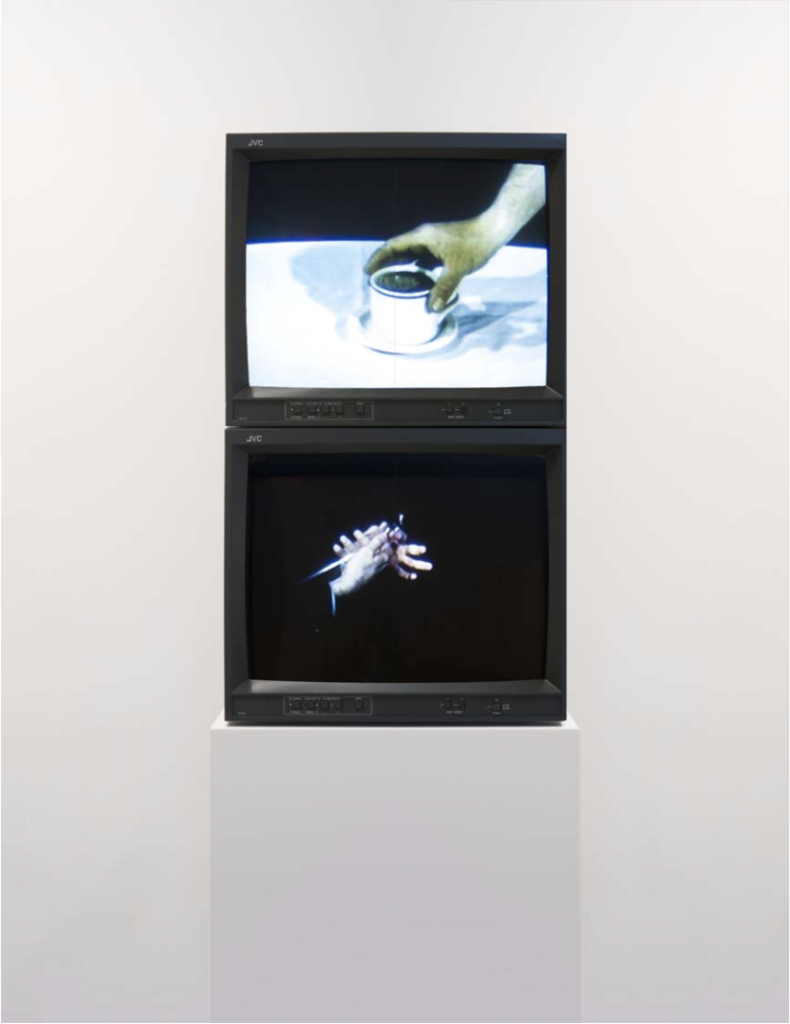
At Sperone Westwater’s booth, a stack of two videos by Bruce Nauman played on asynchronous loops. In the bottom one, the magician Mark Mitton is seen in slow motion as he creates a balloon dog, inflating the rubber tube and then gracefully contorting it with his hands into the friendly, recognizable shape; on top, Nauman’s own hand can be seen lifting a full coffee cup and then repeatedly letting it fall back onto the table, sending geysers of black liquid shooting through the air. Juxtaposing elegance and clumsiness, control and chaos, the work is primo Nauman, containing within its mysteries an embedded biography of the legendary artist.
Like any good day, Nauman’s career started with coffee: the very first artwork in his catalogue raisonné is a ceramic coffee cup that he made at art school at UC Davis. As he began to explore the possibilities of the studio, where he claimed that everything an artist does constitutes art, his ever-present coffee cup became a recurrent prop. As for the magic, Nauman’s grandfather was an amateur magician, who would entertain the family with parlor tricks, and magicians, clowns, and other uncanny performers are classic motifs of his art.
Video is arguably Nauman’s most important medium, which he has employed ever since Leo Castelli let him borrow a Portapak in the late ‘60s. This video stack, meanwhile, was part of Nauman’s US pavilion at the 2009 Venice Biennale when he won the Golden Lion, the pinnacle of his career.
Despite its tumultuous coffee cup, the piece also shows a gentler side of Nauman, who is often associated with his more psychologically assaultive work, according to his longtime dealer, Angela Westwater. “When I took my daughter to see Clown Torture she said it was the scariest thing she’d ever seen,” she remembered. “But that’s not Bruce Nauman—that’s a side of Bruce Nauman.”
Westwater would know. Having represented Nauman for 40 years—one of the most extraordinary dealer-artist partnerships of our time—“I’ve probably seen more of Bruce’s work than anybody other than Bruce,” she said. Next year, they will have reason to celebrate their achievements when curator Kathy Halbreich’s career retrospective of Nauman opens at the Schaulager in Basel, then tours to MoMA in the fall. These videos, which are priced at “almost $2 million,” also testify that Nauman is also belatedly receiving his market due as well.